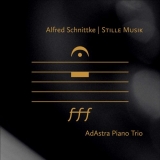Alfred Schnittkes 1. Cellosonate entstand 1978, kurz nach dem Concerto Grosso Nr. 1 und der Beethoven-Kadenz, die ihn bekannt machten. Auch die Sonate ist polystilistisch, Walzeranklänge, Cluster und Neobarock wechseln sich ab. Das Klaviertrio, von Schnittke selber aus dem Streichtrio gestaltet, entstand dann nach seinem Herzinfarkt, der sein Leben und damit auch sein Schaffen grundlegend änderte. Es ist ein zugängliches, zugleich erschütterndes Werk, in dem Schnittke Grenzerfahrungen vertont und instrumental von letzten Dingen spricht.
Dazu kommen die drei kürzeren Werke in Duobesetzung. Im Duo ‘Stille Nacht’ für Violine und Klavier unterwirft er das Lied einer Metamorphose, wodurch ein schemenhaftes Umkreisen der Melodie zu einem immer introvertierteren Klang führt, der berührt.
Diesen unterschiedlichen Aspekten aus Stilen und auch Stimmungen gibt das AdAstra Piano Trio mit leidenschaftlichem Spiel eine überzeugende Umsetzung. In ihrem Zugriff vereinen sie Begeisterung und Liebe zur Kammermusik im Allgemeinen und zu der von Schnittke im Besonderen.
Aus zunächst gelegentlichen Zusammenkünften haben die drei auch sonst in Polen aktiven Musiker seit beinahe zehn Jahren das Trio geformt. Ein Schwerpunkt liegt für sie in der Musik des XX. und XXI. Jahrhunderts, was unschwer auf dieser Aufnahme zu erfahren ist. Die Musik des in Russland geborenen Alfred Schnittke stellt mit ihrer leichten Zugänglichkeit, die aber immer wieder durch schroffe Einwürfe unterbrochen wird, eine sehr eigenständige Stimme hat. Ob im Duo oder als Trio die Musiker bieten ebenso ausgereifte wie gestalterisch nuanciert zeichnende Interpretationen der Werke an, die das Ergebnis ihrer Auseinandersetzung zum Genuss werden lassen.
Schnittke’s First Cello Sonata was composed in 1978 shortly after the Concerto Grosso No. 1 and the Beethoven Cadenza, which made him famous. The sonata is also polystylistic, alternating waltz sounds, clusters and neo-baroque. The Piano Trio, fashioned by Schnittke himself from the String Trio, was written after his heart attack, which fundamentally changed his life and thus his creativity. It is an accessible, at the same time harrowing work in which Schnittke sets borderline experiences to music and speaks instrumentally of ultimate things. In addition, there are the three shorter works in duo instrumentation. In the duo Silent Night for violin and piano, he subjects the song to a metamorphosis, whereby a shadowy circling of the melody leads to an increasingly introverted sound that is touching.
The AdAstra Piano Trio gives these different aspects of styles and also moods a convincing realization with passionate playing. In their approach they unite enthusiasm and love for chamber music in general and for that of Schnittke in particular. From occasional meetings at first, the three musicians, who are also otherwise active in Poland, have formed the trio for almost ten years. A main focus for them is the music of the 20th and 21st centuries, which can be easily experienced on this recording.
The music of Russian-born Alfred Schnittke, with its easy accessibility but repeatedly interrupted by abrupt interjections, has a very distinctive voice. Whether in duo or as a trio the musicians offer interpretations of the works that are as mature as they are nuanced in terms of design, making the result of their exploration a pleasure to listen to.
























